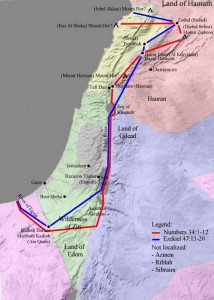 “And you will have the corner of the Negev, the Wilderness of Zin by way of Edom, and this will be the border of the Negev to the edge of the Salt Sea to the East. The border shall go around from th South to the Scorpions Ascent and cross over towards Zin and it shall come out at Kadesh Barnea and it will go out at Hatzar Adar and Atzmona. And the border from Atzmona will go to the river of Egypt and it will go out West. This shall be the Northern border: from the Great Sea and this shall be the Sea (Western) border. This shall be the Northern border, from the Great Sea it shall turn to Mount Hor, it will come to Hamat and will go out to Zared …” (Numbers / Bamidbar 34: 2- 10)
“And you will have the corner of the Negev, the Wilderness of Zin by way of Edom, and this will be the border of the Negev to the edge of the Salt Sea to the East. The border shall go around from th South to the Scorpions Ascent and cross over towards Zin and it shall come out at Kadesh Barnea and it will go out at Hatzar Adar and Atzmona. And the border from Atzmona will go to the river of Egypt and it will go out West. This shall be the Northern border: from the Great Sea and this shall be the Sea (Western) border. This shall be the Northern border, from the Great Sea it shall turn to Mount Hor, it will come to Hamat and will go out to Zared …” (Numbers / Bamidbar 34: 2- 10)
This is an abridge version of the border of Israel as described in the book of Bamidbar (Numbers). It is one of the divine descriptions of the Land of Israel (another is from Ezekiel, also shown on the map).
Divine Privilege (?)
Although there are many descriptions of Israel’s size and shape in the Bible they all focus on the idea that the size and shape is dictated by God. In a post – modern world this seems to be a very backward concept. We live ina world that despises divinely bequeathed privilege.
Duty
The earlier verse says :
“This is the Land that which fell unto you as an inheritance”
Why does it use the phrase ‘fell’ ?
Rabbi Shlomo Yitzchaki (11th century commentator) wrote:
” Being a land wherein many commandments form its culture and do not form part of the culture of the rest of the world necessitated the delineation of its borders, meaning to say ‘this is the land and inside it are its commandments”.
The bizzare term ‘fell’ coupled with the extensive description of the land indicates that it is land where specific duties form its culture.
Moral Purpose
The inheritance here was not merely an inheritance of physicality but an inheritance of a moral purpose bound in the physical ‘clothing’ of land.
